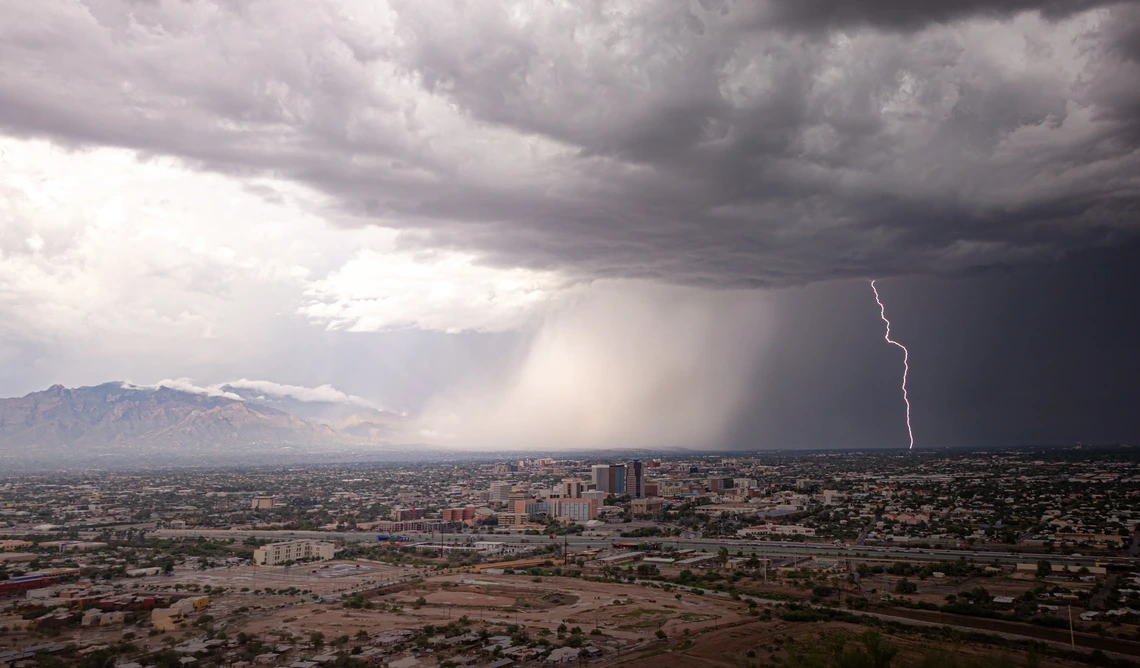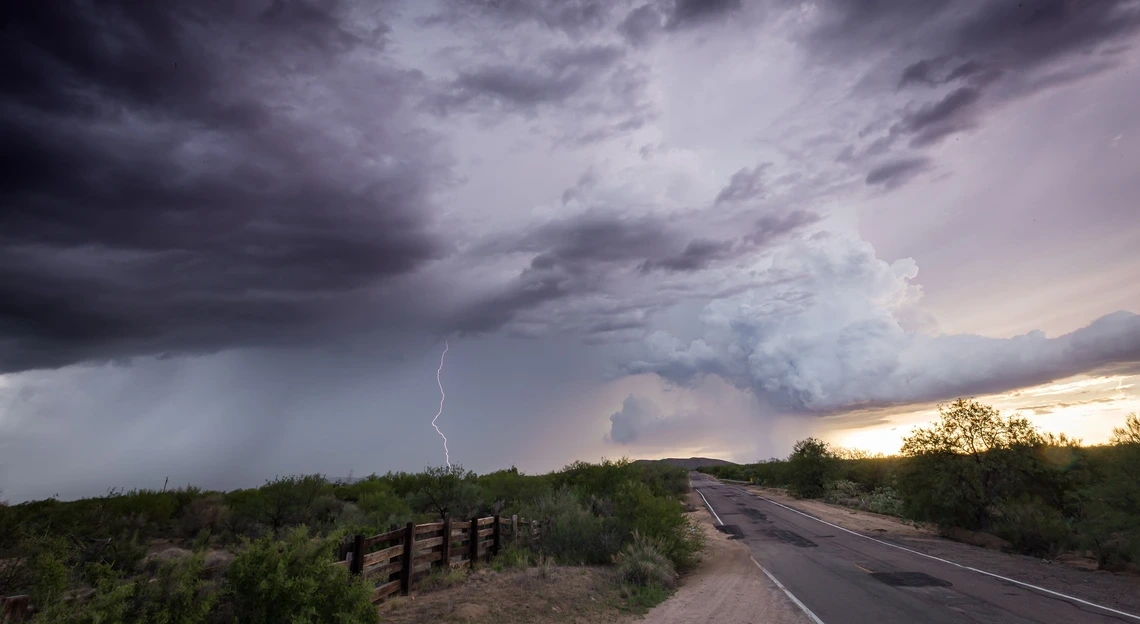Fantasy Forecasts Turn Monsoon Madness Into a Community Guessing Game

What happens when you combine fantasy sports, March Madness and weather forecasts? Southwest Monsoon Fantasy Forecasts allows participants to estimate the amount of rainfall the monsoon will bring each month to a handful of cities throughout the Southwest.
Zack Guido / Arizona Institute for Resilience
While Southern Arizona is famous for its blistering summer heat, those scorching months also signal the arrival of one of the desert's most dramatic – and anticipated – performances: monsoon season.
Defined by the National Weather Service as the time of year between June 15 to Sept. 30, the monsoon brings with it a welcome change when rain breathes new life into the landscape and flora, fauna and parched ground soak in the summer storms.
At the University of Arizona, monsoon season is also a time for friendly competition. Returning for a fifth year is Southwest Monsoon Fantasy Forecasts, a game inspired by fantasy football and March Madness that allows participants to estimate the amount of rainfall the monsoon will bring each month to a handful of cities throughout the Southwest.

Zack Guido
Zack Guido, principal investigator for the fantasy forecasts project and an assistant professor at the Arizona Institute for Resilience, said the game taps into the community's collective excitement surrounding monsoon season and provides an opportunity for the public to learn more about weather and climate science.
"People always want to know what the monsoon will be like, and we have a really hard time answering that question," Guido said. "Much like our weather forecasts, we may know that the conditions are right for rainfall – we just don't have a great idea of where it's going to hit. So, we turned it around and made it a game where we ask the public to play fantasy sports with the weather. We see this as a fun, creative way for people to not only enjoy but learn about the monsoon.
After enrolling in the game, participants enter their guesses for the amount of rainfall they expect each month of the monsoon will bring to different cities, including Tucson and Phoenix. Players have until the last day of June to place their rainfall estimates for July, the first full month the game tracks. Predictions for August must be submitted by the end of July, and predictions for September are due by the end of August.
Wacky weather
It may seem like common knowledge that the summer months bring monsoon storms, but what actually causes the change in weather – and why is it so challenging to predict?
"As the summer progresses in the northern hemisphere, the angle of the sun in the northern hemisphere becomes more direct," Guido said. "We know that the days get hotter and longer, but the atmospheric patterns actually change quite a bit. There is a high-pressure system that sort of parks itself over us in the summer, which leads to the heat. During the monsoon, that high-pressure 'ridge' moves slightly north, which can lead to a favorable flow of moisture from the south and east."

Monsoon storms are driven by seasonal shifts in atmospheric patterns. As summer progresses, a high-pressure system can move northward, potentially allowing moisture from the south and east to flow into the region. Positioned on the northern edge of the monsoon system, Southern Arizona experiences highly variable and difficult-to-predict weather conditions.
Zack Guido / Arizona Institute for Resilience
The monsoon is typically concentrated over Mexico, leaving Southern Arizona on the northern fringe of the weather system. This leads to greater variability in weather and more challenging forecasts as meteorologists and climate scientists struggle to identify reliable indicators for a storm's behavior.
"The location of that high pressure ridge dictates whether there is an incursion of moisture from the south, but it can also shut that incursion down," Guido said. "There are a lot of dynamics and day-to-day nuances like the amount of cloud cover that can make predictions challenging. It's a lot like fantasy sports, a lot of variables matter. You never know if the star quarterback is going to come down with a cold."
While the National Weather Service defines monsoon season on the calendar, Guido added that the wide array of factors involved in the weather phenomenon have historically led to a start date closer to Fourth of July weekend.
Predictive power
Monsoon fantasy forecast contestants searching for a competitive edge in this year's contest should look no further than the Power Forecasting Group. As part of the Arizona Institute for Resilience, the group is sponsored through industry-research partnerships with local electric utility companies, the Pima County Regional Flood Control District and Arizona Department of Environmental Quality to provide high-resolution weather and power forecasts across Arizona and New Mexico.

Patrick Bunn
Forecasts generated by the group are precise enough to track individual clouds, providing a detailed, moment-by-moment account of weather throughout the region.
"We forecast for renewable energy sites like wind and solar farms throughout the Southwest," said Patrick Bunn, senior research scientist and principal investigator of the Power Forecasting Group. "We predict variables like solar irradiance and wind speed and translate that information into power forecasts using a variety of models. While the monsoon is not great in terms of solar power generation, utility companies are interested in forecasting severe weather like strong winds and flooding that could down power lines and create outages."
Aside from up-to-date forecast maps and trackers, the Power Forecasting Group also offers daily weather discussions hosted by Pat Holbrook, a weather forecaster with the institute. Included in the daily discussions are recaps of the previous day's weather, as well as an analysis of regional weather patterns and predictions for the following day.
"We analyze weather maps to look for specific indicators that may enhance precipitation or pivot a storm away, in order to create something that is understandable to everyone," Holbrook said. "We try to show examples and define acronyms so that people can comprehend."
Looking forward to the 2025 monsoon season, Holbrook said he is excited to share his passion for weather with the community – and hopes a few amateur climate scientists learn a thing or two from his discussions.

